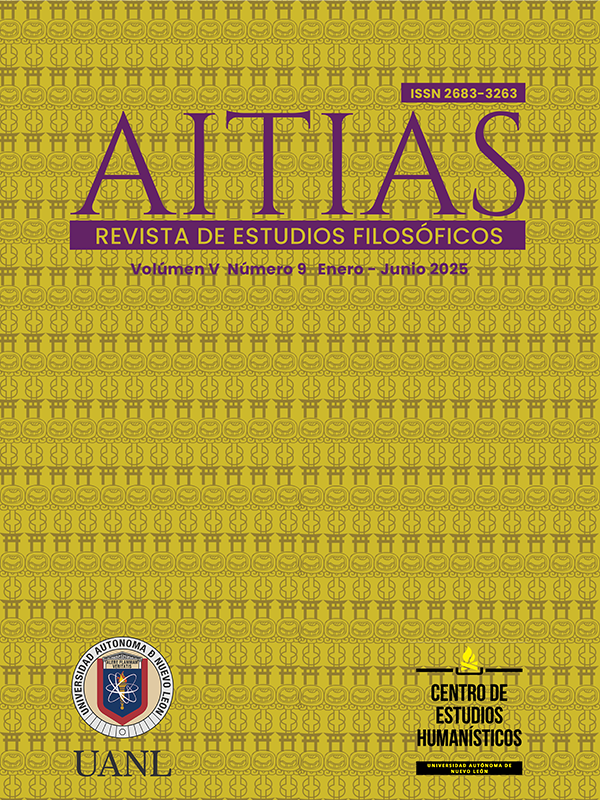La catégorization dans la première enfance: contributions à l’étude de la conaissance
DOI :
https://doi.org/10.29105/aitias5.9-108Mots-clés :
Épistémologie, catégorisation, petite enfance, caractère, langueRésumé
Les théories philosophiques concernant la connaissance ont besoin d’une approche interdisciplinaire pour réussir à répondre à plusieurs questions. À cet égard, cet article cherche à offrir un cadre théorique à partir de la psychologie cognitive et les sciences cognitives, qui aide à comprendre le processus d’acquisition et de transformation de catégories lors de la première enfance. L’article montre des études qui soulignent que la catégorisation utilise des mécanismes (tels que l'attention) et des facultés cognitives (comme le langage) pour créer de nouvelles classifications. Certaines perspectives sur les traitements qui peuvent se produire lors de la catégorisation sont discutées Ainsi, différentes approches théoriques sur le langage et l'attention sont présentées, et il est proposé que le tempérament est une faculté innée qui pourrait influencer notre manière de catégoriser et, par conséquent, notre façon de connaître le monde.
Téléchargements
Références
Althaus, Nadja y Denis Mareshal,. "Labels Infants' Attention to Commonalities During Novel Category Learning". PLOS ONE 9, no. 7 (2014). https://doi.org/10.1371/journal.pone.0099670. DOI: https://doi.org/10.1371/journal.pone.0099670
Althaus, Nadja y Gert Westermann. "Labels Constructively Shape Object Categories in 10-Month-Old Infants". Journal of Experimental Child Psychology 9, no. 7 (2016). DOI: https://doi.org/10.1016/j.jecp.2015.11.013
Aristóteles. De Anima. Gredos, 1978.
Bhatt, Ramesh S. y Caroline Rovee-Collier. “Infants’ forgetting of correlated attributes and object recognition”. Child Development 67, no. 1 (1996): 172-87. https://doi.org/10.2307/1131694. DOI: https://doi.org/10.1111/j.1467-8624.1996.tb01727.x
Buss, Arnold H., y Robert Plomin. Temperament: Early Developing Personality Traits. Erlbaum, 1984.
Carboni, Alejandra y Gabriel Barg. "Atención". En Manual de introducción a la psicología cognitiva, editado por Alejandro Vásquez Echeverría. UCUR, 2016.
Descartes, René. Meditaciones metafísicas. JG, 2012.
Dixon, Wallace E., y P. Hull Smith. "Attentional Focus Moderates Habituation–Language Relationships: Slow Habituation May Be a Good Thing". Infant and Child Development 17 (2008): 95–108. https://doi.org/10.1002/icd.490. DOI: https://doi.org/10.1002/icd.490
Fodor, Jerry Alan. La modularidad de la mente. Traducido por J. M. Igoa. Morata, 1986.
Goldsmith, Harold Hill y J. J. Campos. "The Structure of Temperamental Fear and Pleasure in Infants: A Psychometric Perspective". Child Development 61 no. 6 (1990): 1944–964. DOI: https://doi.org/10.1111/j.1467-8624.1990.tb03577.x
Goldsmith, Harold Hill y Mary K. Rothbart. "Contemporary Instruments for Assessing Early Temperament by Questionnaire and in the Laboratory". En Explorations in Temperament, editado por J. Strelau y A. Angleitner. Plenum Press, 1991. DOI: https://doi.org/10.1007/978-1-4899-0643-4_16
Heck, Alison, A. Hock, H. White, R. Jubran y R. S. Bhatt "The Development of Attention to Dynamic Facial Emotions". Journal of Experimental Child Psychology 147 (2016): 100–10. https://doi.org/10.1016/j.jecp.2016.03.005. DOI: https://doi.org/10.1016/j.jecp.2016.03.005
Hume, David. An Enquiry Concerning Human Understanding. Clarendon Press, 2007. DOI: https://doi.org/10.1093/owc/9780199549900.001.0001
Kant, Immanuel. Crítica de la razón pura. Gaspar Editores, 1983.
Lakoff, George, y Mark Johnson. Metaphors We Live By. The University of Chicago Press, 1980.
Locke, John. Ensayo sobre el entendimiento humano. FCE, 1999.
Lupyan, Gary, y Molly Lewis. "From Words-as-Mappings to Words-as-Cues: The Role of Language in Semantic Knowledge". Language, Cognition and Neuroscience (2017): 1319–337. https://doi.org/10.1080/23273798.2017.1404114. DOI: https://doi.org/10.1080/23273798.2017.1404114
Mandler, Jean. “Conceptual Categorization”. En Early category and concept development. Making sense of the blooming buzzing confusion, editado por D.H. Rakinson y L.M. Oakes. Oxford University Press, 2003. DOI: https://doi.org/10.1093/oso/9780195142938.003.0005
McConnell, Beth A., y Susan E. Bryson. "Visual Attention and Temperament: Developmental Data from the First 6 Months of Life". Infant Behavior and Development 28, no. 4 (2005): 537–44. DOI: https://doi.org/10.1016/j.infbeh.2005.09.002
Miramontes, M. V. “Temperamento y las redes atencionales”. Tesis no publicada, Universidad Autónoma del Estado de Morelos, 2019.
Navon, David, y Daniel Gopher. "On the Economy of the Human-Processing System". Psychological Review 86, no. 3 (1979): 214. DOI: https://doi.org/10.1037//0033-295X.86.3.214
Perinat, Adolfo. Psicología del Desarrollo: Un Enfoque Sistémico. Editorial UOC, 2003.
Platón. Menón. Gredos, 1988.
Plunkett, Kim, Jon-Fan Hu y Leslie B. Cohen. "Labels Can Override Perceptual Categories in Early Infancy". Cognition 106, no. 2 (2008): 665–81. https://doi.org/10.1016/j.cognition.2007.04.003. DOI: https://doi.org/10.1016/j.cognition.2007.04.003
Plunkett, Kim. "The Role of Auditory Stimuli in Infant Categorization". ResearchGate (2011): 203–22. DOI: https://doi.org/10.1093/acprof:oso/9780195366709.003.0010
Putnam, Hilary. "Brains in a Vat". En Skepticism: A Contemporary Reader, editado por Keith DeRose y Ted A. Warfield. Oxford University Press, 1999.
Quinn, Paul C. "Born to Categorize". En The Wiley-Blackwell Handbook of Childhood Cognitive Development. 2a ed. Wiley-Blackwell, 2011. DOI: https://doi.org/10.1002/9781444325485.ch5
Richler, Jennifer J., e Isabel Gauthier. "A Meta-analysis and Review of Holistic Face Processing". Psychological Bulletin 140, no. 5 (2014): 1281–302. https://doi.org/10.1037/a0037004. DOI: https://doi.org/10.1037/a0037004
Richler, Jennifer J., Thomas J. Palmeri e Isabel Gauthier. "Meanings, Mechanisms, and Measures of Holistic Processing". Frontiers in Psychology 3 (2012): 553. https://doi.org/10.3389/fpsyg.2012.00553 DOI: https://doi.org/10.3389/fpsyg.2012.00553
Robinson, Christopher W., y Vladimir M. Sloutsky. "Auditory Dominance and Its Change in the Course of Development". Child Development 75 (2004): 1387–401. https://doi.org/10.1111/j.1467-8624.2004.00747.x. DOI: https://doi.org/10.1111/j.1467-8624.2004.00747.x
Rothbart, Mary K., Brad E. Sheese y Michael I. Posner. "Executive Attention and Effortful Control: Linking Temperament, Brain Networks, and Genes". Child Development Perspectives 1, no. 1 (2007): 2–7. https://doi.org/10.1111/j.1750-8606.2007.00002.x DOI: https://doi.org/10.1111/j.1750-8606.2007.00002.x
Spinoza Baruch. Ética demostrada según el orden geométrico. Tecnos, 2007.
Strelau, Jan. "The Location of the Regulative Theory of Temperament (RTT) among Other Temperament Theories". En Foundations of Personality, 113–132. Springer Netherlands, 1993. DOI: https://doi.org/10.1007/978-94-011-1660-2_9
Strelau, Jan. Temperament: A Psychological Perspective. Springer Science & Business Media, 1998.
Styles, Elizabeth A. Psicología de la atención. Editorial Centro de Estudios Ramón Areces, 2010.
Thomas, Alexander y Stella Chess. Temperament and Development. Brunner/Mazel, 1977.
Treisman, Anne. "Representing Visual Objects". Attention and Performance 14 (1993): 163–75. DOI: https://doi.org/10.7551/mitpress/1477.003.0014
Tversky, Barbara. "Parts, Partonomies, and Taxonomies". Developmental Psychology 25, no. 6 (1989): 983-95. DOI: https://doi.org/10.1037//0012-1649.25.6.983
Vonderlin, Eva, Janna Pahnke, y Sabina Pauen. "Infant Temperament and Information Processing in a Visual Categorization Task". Infant Behavior and Development 31, no. 4 (2008): 559–69. https://doi.org/10.1016/j.infbeh.2008.07.011. DOI: https://doi.org/10.1016/j.infbeh.2008.07.011
Waxman, Sandra R. "Specifying the Scope of 13-Month-Olds' Expectations for Novel Words". Cognition 70, no. 3 (1999): 35–50. DOI: https://doi.org/10.1016/S0010-0277(99)00017-7
Whorf, Benjamin Lee. Language, Thought and Reality. Barrales, 1956.
Wilk, A. C., R. S. Bhatt y C. Rovee-Collier. "Correlated Attributes and Categorization in Infancy". Ponencia presentada en la reunión de la Society for Research in Child Development, Indianápolis, IN. 1995.
Wittgenstein, Ludwig. Investigaciones Filosóficas. UNAM, s.f.
Younger, Barbara A. Early Category and Concept Development: Making Sense of the Blooming, Buzzing Confusion. Oxford University Press, 2003.
Younger, Barbara A., y Leslie B. Cohen. "Developmental Change in Infants' Perception of Correlations among Attributes". Child Development 57 (1986): 803–15. DOI: https://doi.org/10.1111/j.1467-8624.1986.tb00247.x
Zieber, Nicole, A. Kangas, A. Hock y R. S. Bhatt. “Body structure perception in infancy”. Infancy 20, no. 1 (2015): 1-17. DOI: https://doi.org/10.1111/infa.12064
Téléchargements
Publiée
Comment citer
Numéro
Rubrique
Catégories
Licence
© Georgina Sandoval Monreal, Alberto Jorge Falcón Albarrán 2025

Ce travail est disponible sous licence Creative Commons Attribution - Pas d’Utilisation Commerciale 4.0 International.
Los autores/as que publiquen en esta revista aceptan las siguientes condiciones:
1. Los autores/as conservan los derechos de autor y ceden a la revista AITÍAS el derecho de la primera publicación, con el trabajo registrado con la licencia de atribución de Creative Commons CC-BY, que permite a terceros utilizar lo publicado siempre que mencionen la autoría del trabajo y a la primera publicación en esta revista.
2. Los autores/as pueden realizar otros acuerdos contractuales independientes y adicionales para la distribución no exclusiva de la versión del artículo publicado en esta revista (p. ej., incluirlo en un repositorio institucional o publicarlo en un libro) siempre que indiquen claramente que el trabajo se publicó por primera vez en AITÍAS, Revista de Estudios Filosóficos del Centro de Estudios Humanísticos de la UANL.












